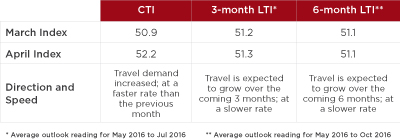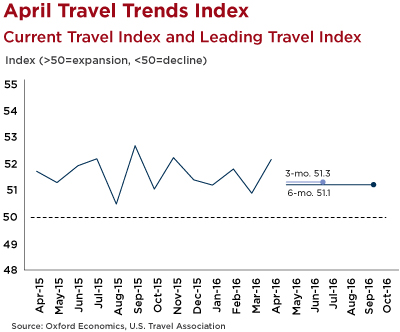WASHINGTON (June 7, 2016)—Stronger international demand and the first positive month for domestic business travel in over a year propped up travel growth in April 2016, according to the U.S. Travel Association’s Travel Trends Index (TTI).
The association’s monthly economic indicator predicts moderate travel expansion into late 2016, with international inbound growth rivaling that of domestic travel overall. For much of 2016 thus far, the strong U.S. dollar has proven a drag on the demand for international travel to the U.S., and April’s report predicts a welcome rebound.
The April Current Travel Index (CTI) rose to 52.2, signaling the 76th straight month of growth for the travel industry (numbers above 50 indicate growth, and scores below 50 show contraction).
In the full Travel Trends Index report, the 3- and 6-month LTI readings of 51.3 and 51.1, respectively, indicate that U.S. travel overall is expected to grow at a rate of around two percent through October 2016.
Domestic business travel grew in April for the first time since March 2015. However, forecasters still expect the coming months to see abiding caution from businesses in the face of international market fluctuation.
Domestic leisure travel continued its steady growth in April, and is still expected to lead overall U.S. travel growth into late 2016. Furthermore, the TTI’s Leading Travel Index (LTI) projects a rebound for international inbound travel through late 2016 as well, with growth in international demand going toe-to-toe with domestic travel overall.
“This month’s report signals a ‘reversal of fortunes’ of sorts for much of the travel industry in the coming months,” said U.S. Travel Association Senior Vice President for Research David Huether. “Domestic travel as a whole appears poised to take a backseat to international inbound travel in the near term, after outpacing it for the better part of a year. Domestic business travel grew in April for the first time in 13 months.
“April was the beginning of what we anticipate will be an inversion of many previously long-lived travel trends, amid continued overall growth.”
The TTI consists of the Current Travel Index (CTI), which measures the number of person-trips involving hotel stays and/or flights each month, and the Leading Travel Index (LTI), which measures the likely average pace and direction of business and leisure travel, both domestic and international inbound. It assigns a numeric score to every travel segment it examines—domestic and international, leisure and business—in current, 3-month predictive and 6-month predictive indicators. As with many indices similarly measuring industry performance, a score above 50 indicates growth, and a score below 50 indicates contraction.
The U.S. Travel Association developed the TTI in partnership with Oxford Economics, and draws from multiple data sources to develop these monthly readings. In order to compile both the CTI and LTI readings, the organization’s research team utilizes multiple unique non-personally identifiable data sets, including:
- Advance search and bookings data from ADARA and nSight;
- Passenger enplanement data from Airlines for America (A4A);
- Airline bookings data from the Airlines Reporting Corporation (ARC); and
- Hotel room demand data from STR.
Learn more about the Travel Trends Index.
Click here to read the full report.



